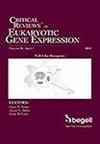Cancer cell type dependent modifications of metastatic parameters by SLIT2-ROBO1 and RHOA cAMP signaling in response to TGFB1 and FGF2
IF 1.5
4区 医学
Q4 BIOTECHNOLOGY & APPLIED MICROBIOLOGY
Critical Reviews in Eukaryotic Gene Expression
Pub Date : 2024-06-01
DOI:10.1615/critreveukaryotgeneexpr.2024054055
引用次数: 0
Abstract
The epithelial to mesenchymal transition (EMT) is a multistep process involving structural and functional alterations that are required for cancer metastasis, as well as loss of epithelial markers (e.g., E-cadherin/CDH1) and gain of mesenchymal markers (e.g., N-cadherin/CDH2, vimentin/VIM). Pathological events modify cell-cell interactions, cell-matrix adhesion and extra cellular matrix integrity leading to cell migration, evasion from the primary tumor and augmented invasiveness in the metastatic niche. This transformation is modulated by multiple paracrine factors (e.g., chemokines, growth factor), as well as SLIT2-ROBO1 signaling that collectively regulate expression of RHO GTPases (e.g., RHOA) and EMT marker genes. Yet, the roles of SLIT proteins in cancer remain enigmatic. In some cancer types, SLIT2 is anti-tumorigenic, while in other cancers it contributes towards the metastatic phenotype. Here we investigated the ambivalent metastatic activity of SLIT2 by analyzing how cAMP/RHOA signal transduction modulates SLIT-ROBO controlled metastatic parameters in response to the phosphodiesterase inhibitor IBMX (3-isobutyl-1-methylxanthine) and paracrine factors (TGF-β/TGFB1 and FGF2). Upon SLIT2 administration cell migration and proliferation increases in colon cancer cells and decreases in cervical cancer cells, while altering cell morphology and proliferation in both cancer types. These effects are reinforced by TGF-β/TGBF1 and FGF2, but attenuated by elevation of cAMP with IBMX, depending on the cancer cell type. Our data indicate that SLIT2 represents a potential biomarker for cancer diagnosis, prognosis, and therapy.癌细胞类型依赖于 SLIT2-ROBO1 和 RHOA cAMP 信号对 TGFB1 和 FGF2 转移参数的改变
上皮向间充质转化(EMT)是一个多步骤过程,涉及癌症转移所需的结构和功能改变,以及上皮标志物(如 E-cadherin/CDH1)的缺失和间充质标志物(如 N-cadherin/CDH2、vimentin/VIM)的增殖。病理事件改变了细胞与细胞之间的相互作用、细胞与基质之间的粘附以及细胞外基质的完整性,从而导致细胞迁移、逃离原发肿瘤并增强转移龛的侵袭性。这种转变受到多种旁分泌因子(如趋化因子、生长因子)以及 SLIT2-ROBO1 信号的调节,它们共同调节 RHO GTP 酶(如 RHOA)和 EMT 标记基因的表达。然而,SLIT 蛋白在癌症中的作用仍然是个谜。在某些癌症类型中,SLIT2 具有抗肿瘤作用,而在另一些癌症中,它则有助于形成转移表型。在这里,我们通过分析 cAMP/RHOA 信号转导如何调节 SLIT-ROBO 在磷酸二酯酶抑制剂 IBMX(3-异丁基-1-甲基黄嘌呤)和旁分泌因子(TGF-β/TGFB1 和 FGF2)作用下控制的转移参数,研究了 SLIT2 的矛盾转移活性。服用 SLIT2 后,结肠癌细胞的迁移和增殖增加,宫颈癌细胞的迁移和增殖减少,同时这两种癌症类型的细胞形态和增殖都发生了改变。这些效应在 TGF-β/TGBF1 和 FGF2 的作用下会得到加强,但在 IBMX 提高 cAMP 的作用下会减弱,具体取决于癌细胞类型。我们的数据表明,SLIT2 是癌症诊断、预后和治疗的潜在生物标记物。
本文章由计算机程序翻译,如有差异,请以英文原文为准。
求助全文
约1分钟内获得全文
求助全文
来源期刊

Critical Reviews in Eukaryotic Gene Expression
生物-生物工程与应用微生物
CiteScore
2.70
自引率
0.00%
发文量
67
审稿时长
1 months
期刊介绍:
Critical ReviewsTM in Eukaryotic Gene Expression presents timely concepts and experimental approaches that are contributing to rapid advances in our mechanistic understanding of gene regulation, organization, and structure within the contexts of biological control and the diagnosis/treatment of disease. The journal provides in-depth critical reviews, on well-defined topics of immediate interest, written by recognized specialists in the field. Extensive literature citations provide a comprehensive information resource.
Reviews are developed from an historical perspective and suggest directions that can be anticipated. Strengths as well as limitations of methodologies and experimental strategies are considered.
 求助内容:
求助内容: 应助结果提醒方式:
应助结果提醒方式:


